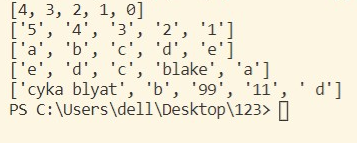this is a note
l0 = 'acoilia.kinlrmi.3000.clevorihno'
l1 = l0.split('.') #列表是可变类型
print(l1) #li现在是列表了
def return_function(): #these functions return values
a = l1[0] #list1 = [index of the element]
#b = len(l1) #shows how many elements in list.
#c = 'kinlrmi' in l1 #"in" or "not in". return a bool type
#d = l1.index('clevorihno') #↓.no such a "find"function in list_operation
#e = l1.count('acoilia') #same as the "count"function in str_operation
#f = l1.copy() #copy list and reurn value to f
def none_return_function(): #changes original list directly and no return valuesa
l1[0] = 'ahhh ' #[index],change [index] to "ahhh "
#l1.reverse() #as function's name says
#l1.sort() #default:(reverse = false)
#l1.append('is') #only add new data/list to end of l1.
#l1.extend(['my','friend']) #able to add new list's elements to end of l1.('str')is also right form
#l1.insert(0,'the') #(index,'data')
#l1.remove('the') #('data')
l1.clear() #after this,list is an empty list.
def speical_function():
#f = l1.pop() #(index).default:pop the last one
#↑pop is more like "pick it out of list" but "delete",cuz var j returns a data,which is what's deleted.
#1.sort() #ording by initial character when dealing with a string contains letter/number.
#↑this is only one of many ways to use
#del l1[0] #delete [index] element.
del l1 #delete the whole list,include var_name.
return_function()
none_return_function()
speical_function()
print(l1)
需要验证哪个函数把#取掉就好了。另外这位博主写的文章很详细地写出了函数的规则。不知道这样引用人家的文章行不行
下面是一点简单的猜测
因为关于sort()的排序规则我无从得知,所以以下结论仅通过操作得到的规律中发现。
首先sort的书写规则应该是这样的:
listx.sort( key = , reverse = )
- 因为是列表所以暂时不需要key。reverse默认值是False。请注意F要大写。
那么,先来看一下以下几种情况:
list0 = [0,1,2,3,4] #number:integer
list1 = ['1','2','3','4','5'] #number:string
list2 = ['a','b','c','d','e'] #letter:string
list3 = ['a','blake','c','d','e'] #letter&word:string
list4 = ['99','b','cyka blyat',' d','11'] #number&letter&word:string
list0.sort(reverse = True) #倒序排列(大 → 小)
list1.sort(reverse = True)
list2.sort(reverse = False) #顺序排列(小 → 大)
list3.sort(reverse = True)
list4.sort(reverse = True)
print(list0)
print(list1)
print(list2)
print(list3)
print(list4)
- 请注意list4中的’空格d’,不是’d’
我草这个编辑器有毒
那么运行,得到结果:

可以看出:
- list0 ,list1采用倒序排列,冇闷台
- list2采用顺序排列,no趴笨
那么暂时通过以上三个列表得出的结论可以认为是:
sort()按照列表元素的下标/索引进行排序。
似乎也许大概八成好像差不多不一定 没错但是:
list4中,
扫描二维码关注公众号,回复:
9127255 查看本文章


[‘99’,‘b’,‘cyka blyat’,’ d’,‘11’]
那么理论上如果按照下标排序,得到的结果应该是
[‘11’,‘d’,‘cyka blyat’, ’ b’,‘99’]
但是实际上得到
[‘cyka blyat’, ‘b’, ‘99’, ‘11’, ’ d’]
所以我推了推眼镜 认为:
- sort()应该是按照 列表中每一个元素的 首字符 的ascii码值 排列的。
那么这样一来的话,把list4中每个元素的首字符的ascii码写出来就是这样子:
[57,98,99,32,49]
那么,理论上来说list4排列的结果就和[ ‘9’,‘b’,‘c’,‘ ’,‘1’ ]是一样的。
list4 = ['99','b','cyka blyat',' d','11']
list5 = ['9','b','c',' ','1']
list4.sort(reverse = True)
list5.sort(reverse = True)
print(list4)
print(list5)

顺带一提大写字母和小写字母的ascii码值是不一样的,A = 65,a = 97,差值是32
以上就是我的全部 意淫 脑补 科学考察 过程。
(不保证正确性)
